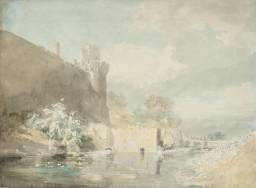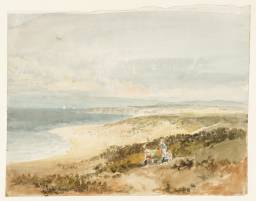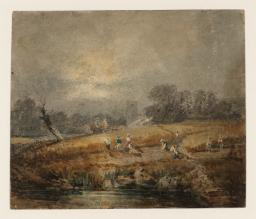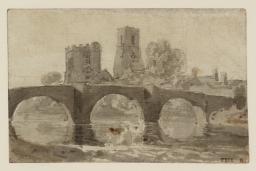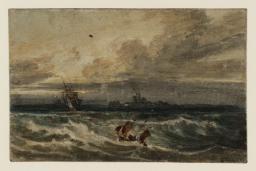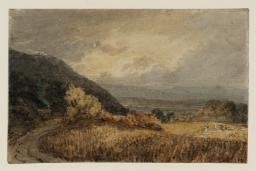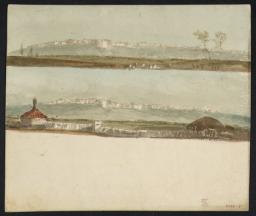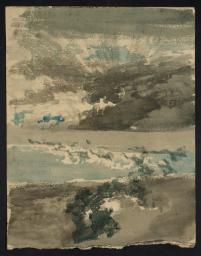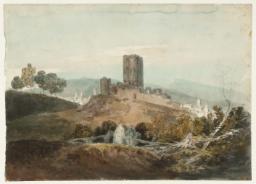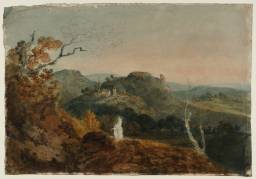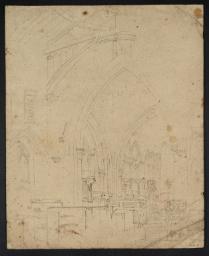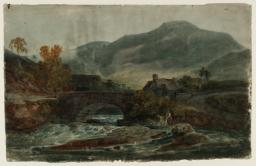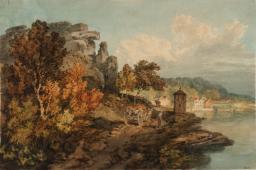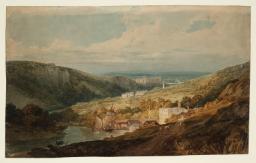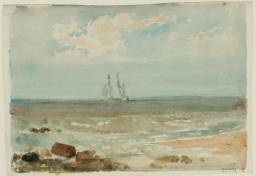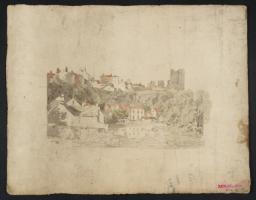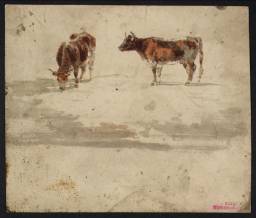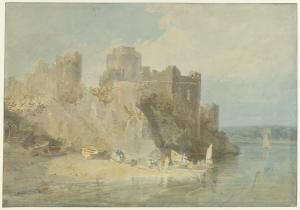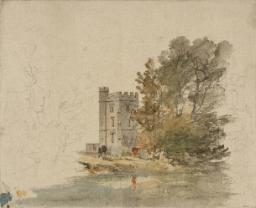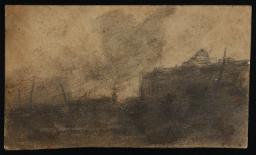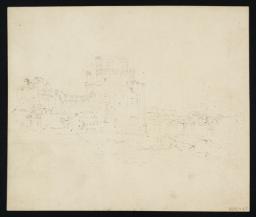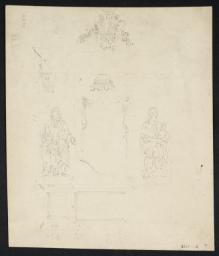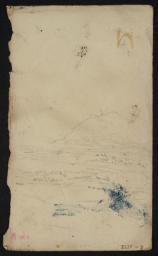D00329, D00701, D00706–D00709, D00715, D00717, D00724, D00725, D00727, D00728, D00872, D00874, D00875, D00878, D00879, D00895, D00900, D00901, D01877, D01882–D01889, D01892, D01894–D01897, D01900–D01903, D01906, D01911, D02342, D02352, D02354, D02355, D02377, D02381, D03422, D04159, D04174, D08202, D08203, D36625, D36659, D40058, D40059, D40105, D40246, D40249, D40341, D40255–D40257, D41440
Turner Bequest XXI C, XXVIII P, XXIX A, B, C, D, J, L, S, T, V, W, XXXIII A, C, D, G, H, X, c, d, XLIV A, F, G, H, I, J, K, L, M, P, R, S, T, U, X, Y, Z, a, d, i, L A, K, M, N, LI J, N, LVIII 43, LXX H, W, CXIX O, P, CCCLXXIX 1, CCCLXXX 10
The first works considered in this subsection form a short sequence of views in Kent (D00701, D00878, D00895, D01903; Turner Bequest XXVIII P, XXXIII G, X, XLIV a). Because of Turner’s family connections with Margate, he was in the habit of travelling along the north Kent coast from an early age. In the course of the 1790s he additionally contracted some important friendships which took him to Kent, notably those with the Rev. Robert Nixon (1759–1837), who was one of his pupils, and another clergyman, Henry Fly, curate of St Katharine’s, Knockholt.1 A visit to Nixon in 1798 resulted in a number of drawings of Kent subjects in the South Wales sketchbook that he had used in 1795 (Tate; Turner Bequest XXVI); these include the view of Allington Castle that he worked up in the sheet (Tate D01903; Turner Bequest XLIV a). A fellow-watercolourist and close friend, William Frederick Wells (1762–1836), was to move to Knockholt in 1801. The small oil paintings of beech and other trees, made at Knockholt and Chevening in the years around 1800, were also fruit of these friendships (various collections).2
Next come drawings and watercolours of Welsh and related subjects (D00329, D00872, D00875, D01877, D01900–D01902, D01906, D01911, D02352, D02354, D03422; Turner Bequest XXI C, XXXIII A, D, XLIV A, X, Y, Z, d, i, L K, M, LVIII 43). Turner’s tour of Wales in the summer of 1798 is recorded in several sketchbooks: Hereford Court, North Wales, Dynevor Castle, Cyfarthfa, and Swans (Tate; Turner Bequest XXXVIII, XXXIX, XL, XLI, XLII); he also made drawings on loose sheets of paper and card, and worked up some subjects with finished watercolours in mind. These individual sheets are catalogued in this subsection. Other Welsh subjects, drawn on card, are discussed later in the Introduction along with drawings on similar supports.
Four watercolours addressed here (D00724, D00725, D00874, D00879; Turner Bequest XXIX S, T, XXXIII C, H) may constitute a series of imaginary, or partly imaginary, landscape compositions. Also relevant in this context is A Dark Landscape with Trees and Mountains, a small oil study on canvas of about 1798–9 (Tate D02380; Turner Bequest LI M).3 It is based on a pencil drawing in the 1798 Dynevor Castle sketchbook (Tate D01476; Turner Bequest XL 8a), and suggests the setting for a heroic historical or mythical drama; the Plagues of Egypt or Pyramus and Thisbe are among possible subjects. Another oil study, probably painted slightly later, on paper, and also depicting a sombre subject, is the Stormy Landscape with Figures (Tate D05960; Turner Bequest XCV a G).4
The remainder of this subsection comprises miscellaneous subjects grouped mainly on account of their similar supports. The first grouping (D00706–D00709, D00715, D00717, D00900, D00901, D01883–D01889, D01892, D01894–D01896, D02377, D04174, D36625, D36659; Turner Bequest XXIX A, B, C, D, J, XXIX L, XXXIII c, d, XLIV G, H, I, J, K, L, M, P, R, S, T, LI J, LXX W, CCCLXXIX 1, CCCLXXX 10), the bulk of which are on thin card cut into pieces approximately 152 x 178 mm (though with some variation), all give the appearance of having been made in front of the motif, but it is also fairly clear that they do not belong to a single journey. The views of Caernarvon, for instance, presumably date from 1798 and perhaps fed into the gestation of the view of Caernarvon Castle exhibited at the Royal Academy in 1799 (private collection),5 though the orientation of that view is closer to a watercolour study on laid paper, Tate D01901 (Turner Bequest XLIV Y). Further drawings on cards similar to those with Welsh subjects appear to have been made in the Home Counties or Oxfordshire. New identifications of studies made at Ludlow and Chipping Norton help to identify the route Turner took on his way back from North Wales in 1798.
A view of Norham Castle (D36625; Turner Bequest CCCLXXIX 1) is among those on smaller cards, or drawings related to these, which have been the subject of controversy, some authorities having considered them to be the work of Thomas Girtin (1775–1802). Although some in Turner Bequest section CCCLXXIX are clearly by Girtin and thus outside the immediate scope of this catalogue, others are certainly by Turner himself; the arguments for these attributions have been given elsewhere by the present author.6 Cards on which Turner has jotted architectural details (D01888, D01889, D01890; Turner Bequest XLIV L, M, N) may belong to his work in and around Salisbury in 1788–9; compare the architectural study Tate D01890 (Turner Bequest XLIV N).
Finally, various drawings (D00727, D00728, D01882, D01897, D02342, D02355, D02381, D04159, D08202, D08203 (Turner Bequest XXIX V, W, XLIV F, L A, N, U, LI N, LXX H CXIX O, P) are grouped together on account of their support, a rough buff wrapping paper which occurs rarely in the Turner Bequest. Although two of the subjects are scenes at Stanton Harcourt, near Oxford, and the study of a water-mill (Tate D08202; Turner Bequest CXIX O) may have been made in the same area. A fourth drawing, D08203 (Turner Bequest CXIC P), must be a scene in Wales, and the fifth, D00728 (Turner Bequest XXIX W), is of Melrose, which Turner visited during his North of England tour in 1797. Given the fact that the drawings on white card already discussed were done both in Wales and possibly in the vicinity of Oxford, it is not impossible that the Stanton Harcourt subjects were made on the same itinerary. There is no other evidence of Turner’s taking the wrapping paper with him either to the North of England or to Wales, but it is the kind of support he would have been able to find during his tour in country towns where better quality papers were not available.
See Martin Butlin and Evelyn Joll, The Paintings of J.M.W. Turner, revised ed., New Haven and London 1984, p.26.
Ibid., p.25 no.34a, pl.30; see also Andrew Wilton, Turner and the Sublime, exhibition catalogue, Art Gallery of Ontario, Toronto 1980, p.133 no.40, reproduced p.132.
How to cite
Andrew Wilton, ‘Drawings Connected with the Kent and Welsh Tours of 1798, and Other Works c.1797–1802’, subset, March 2013, in David Blayney Brown (ed.), J.M.W. Turner: Sketchbooks, Drawings and Watercolours, Tate Research Publication, April 2015, https://www

